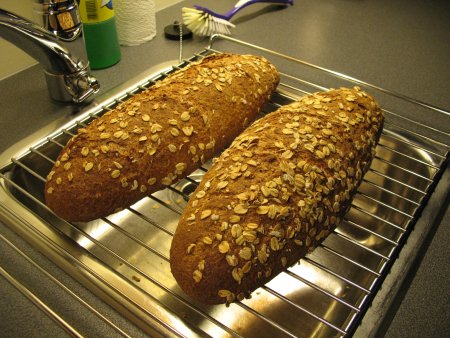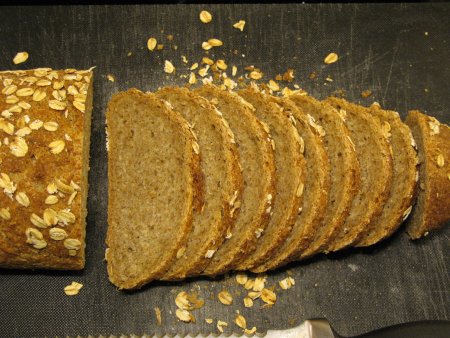I hope everyone had a merry Christmas and lovely new year celebrations!
After getting the rye sauerteig starter from Leader's Local Breads going, I have been gradually working my way through Hamelman's rye sourdoughs. I've become completely enamored with hearty rye loaves, and I feel I am getting a bit better at working with these kinds of doughs.
I've baked the straight oatbread from Bread several times, and it has served as one of my favorite "quick breads" that I make when I don't have the time to do a sourdough/pre-fermented bread. However, I've always thought that it's on the light side, and that it stales pretty fast. So, yesterday I had a go at a modified version, where I replaced some of the bread flour with a rye sauer. This is my first iteration, but I feel it turned out pretty good. I post my working recipe below. Next time, I think I'll substitute some of the bread flour with more wholewheat, to give it an even heartier feel. Suggestions are very welcome, and please let me know how it turns out if you have a go at it!
All the rye flour is pre-fermented (34.7%). Apologize for the awkward percentages, I did some tweaks to a preliminary formula, so most quantities came out with decimal percentages. The amounts below yielded two average sized ovals.
Overall formula
- Wheat flour 260 gr. (42.1%)
- Wholewheat flour 143 gr. (23.2%)
- Whole rye flour 214 gr. (34.7%)
- Rolled oats 143 gr. (23.2%)
- Water 540 gr. (87.5%)
- Oil 54 gr. (8.8%)
- Honey 36 gr. (5.8%)
- Salt 12 gr. (2%)
- Fresh yeast 8 gr. (1.3%)
Rye sourdough
- Whole rye flour 214 gr. (100%)
- Water 214 gr. (100%)
- Rye starter 11 gr. (5%)
Prepare rye sourdough 16 - 18 hrs. before the final dough is mixed. Bulk fermentation: 1 hr. Final fermentation: 50 - 60 minutes. Bake at 240C for 15 minutes, then at 220C for another 20-30 minutes.

- hansjoakim's Blog
- Log in or register to post comments
Hansjoakim,
If those taste as good as they look, you have some really, really good bread.
Paul
and I love the combination of rye and oats.
I've retarded a dough for better than two days in the garage, about refrigerator temp, and it's warming up now. It weighs in at 1500g so it will be an easy 3 pounder! It started out with 1-2-3 sd loaf ratio plus a cup of cooked oatmeal. The starter is rye, part of the water includes milk and part of the flour is also rye. Even unbaked it smells so good! (is it possible to smell potential?) It gets another fold then into a banneton to rise some more. With all the slashing discussion, I'm thinking about a new design. hmmmm... can't wait...
Mini
I have missed your baking and photos...these are beautiful breads....very nicely explained how you made them....thanks for the 'recipe'.
Sylvia
Interesting. I've never tried mixing rye and oats. It looks good.
Thanks for your replies, everyone!
Let's know how that 3 pounder turns out, MiniO, will you?
I was really happy with the combination of rye and oats in this bread. Although slightly denser than Hamelman's oatbread, the crumb is still light. The crust is a bit chewier than Hamelman's version, which I think is a good thing, and the rye starter and a substantial hydration ensures that it keeps very well too. There's also the unmistakable Roggensauerteig tang to it :) For the next iteration, I'll try 50% whole rye, and equal amounts wheat and wholewheat.
Beautiful job, hansjoakim!
Having just gotten enough confidence to make my first rye bread, I am very pleased to see your handiwork. The combination of oats and rye sounds delicious. The oats on the crust give a beautiful rustic look to the final bread.
I used a soaker of sunflower seeds and cracked rye berries and loved the extra texture and the flavor they imparted to the bread.
I kept wondering about the large amounts of rye sourdough in Hamelman's rye recipes. I finally get it: since the bread doesn't ferment or proof for very long, if you want a sour flavor, you have to use more sourdough starter. (Maybe he explained it and I just missed it.)
I'm curious about the inclusion of yeast. Do you think the bread wouldn't rise as much without the yeast, or would removing the yeast and increasing the proof time damage the gluten?
Keep up the great work!
Soundman (David)
Thank you for your nice words, David!
I've just started out on this rye quest myself too, and I think soakers like those you mention (and those we find in Hamelman) impart great flavor and a soft, rich texture to the crumb of the breads.
From what I've gathered, there are several ways to use rye starters in bread production. On one hand you've got the "Hamelman method", where there's typically 30-40% rye sourdough in the overall formula. Since a lot of the flour has already been fermented, there's no need for longer floor time or proofing, as you write. I've been reading a few German Sauerteig resources along with Hamelman, and they are using the same technique, with either a 1-step or a 3-step (Detmold) SD process.
On the other hand, Leader seems to be using rye SD differently in "Local Breads": He's adding a much smaller amount of ripe rye SD to the final dough, but calls for substantially longer fermentation and proofing times.
I've tried both, and I've found that Hamelman's method yields bread with a richer and more sour taste. For me, that's also the most practical way of baking rye SDs, as I can start the pre-ferment before work or before bed.
I'm glad you asked about the yeast in the final dough. To be honest, I haven't had the guts to experiment without yeast so far. Most all the Hamelman recipes (excluding the Detmolder) and other German rye recipes I've tried, have been based on the 1-step build of the rye Sauer. I believe such a 1-step sour would be able to lift the bread, it may take a little while longer, but for optimum leavening, one should preferrably use the 3-step method, as that is tailormade to develop both the SDs low pH and yeast activity. In the 1-step method, yeast activity naturally falls as the pre-ferment becomes more acidic. Longer proofing times could potentially weaken the gluten, but I'm not sure if healthy rye Sauers become that sour?
I just received Andrew Whitley's book "Bread Matters", and I've found a slew of great looking rye SD recipes in that book, most of which don't contain any commercial yeast. I think I'll jump into it this weekend... Thanks again for your kind words, David!
hansjoakim,
Your response was very helpful. I am glad to know another TFL baker who is just beginning the rye adventure. (I ate the last piece of my rye today and immediately knew I have to bake some more rye, and soon!)
I asked about the yeast because I made my rye without it, a la Leader, and got a very decent rise, but then it was only 40% rye flour. (Still, it had a substantial rise-deterrent in the soaker, so there was some resistance to overcome, and the sourdough yeast succeeded.) I'm sure the whole equation changes as the wheat flour decreases, and I'm still trying to understand when I might need yeast and when I can get away with not adding it.
I will look forward to reading your blog and discovering more information about all these wonderful rye recipes. The possiblities with rye seem so rich; ich träume von Vollkornbrot! But I think I will need to gradually increase the rye percentage and learn what adjustments to make as the dough becomes more fragile.
Keep up the great baking and blogging, and I'll check back with you soon!
Soundman (David)